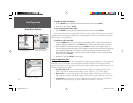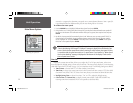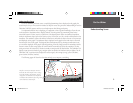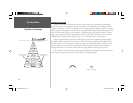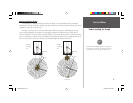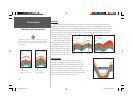
26
Whiteline
The Fishfi nder 250/250C can help you to determine if the bottom is hard or soft. When the sonar
soundwaves are refl ected back by the bottom, a hard bottom returns a stronger signal than a soft bottom.
A thin whiteline indicates a softer bottom while a thick whiteline indicates a harder bottom. Normally, the
Fishfi nder 250 uses a black line and the Fishfi nder 250C uses a red line to show the point where water
meets the bottom. This line follows the bottom contour, along with any signifi cant objects lying on the
bottom. The unit uses the whiteline
function to make this bottom layer
information easier to distinguish.
With the Fishfi nder 250/250C,
whiteline helps accentuate where
strong signals are located, which
make bottom type determination
easier. The example to the right
shows the bottom return with and
without the whiteline activated.
See page 14 for more information.
Thermoclines
One of the unique features offered by Garmin is
See-Thru
®
technology. See-Thru
®
technology allows the
Fishfi nder 250/250C to “see” through thermoclines and
helps locate fi sh where they live -- and fi sh love thermo-
clines. A rough defi nition of a thermocline is a break in
water where the water temperature changes faster than in
the water above it. Thermoclines give weak returns and are
shown as the weakest colors/shades (see pg. 11).
)
Whiteline can also help you to determine the type of bottom struc-
ture that is displayed on the graph. By determining the hardness
of the structure, you can make a better informed decision on the
type of structure.
Structure is hard—
probably a rock or stump
Structure is soft—
probably a mud pile
On the Water
Whiteline and Thermoclines
Thermocline
Whiteline Turned Off
Whiteline
Hard Bottom
Soft Bottom
250C Manual.indd 26 1/27/2004, 3:55:24 PM




